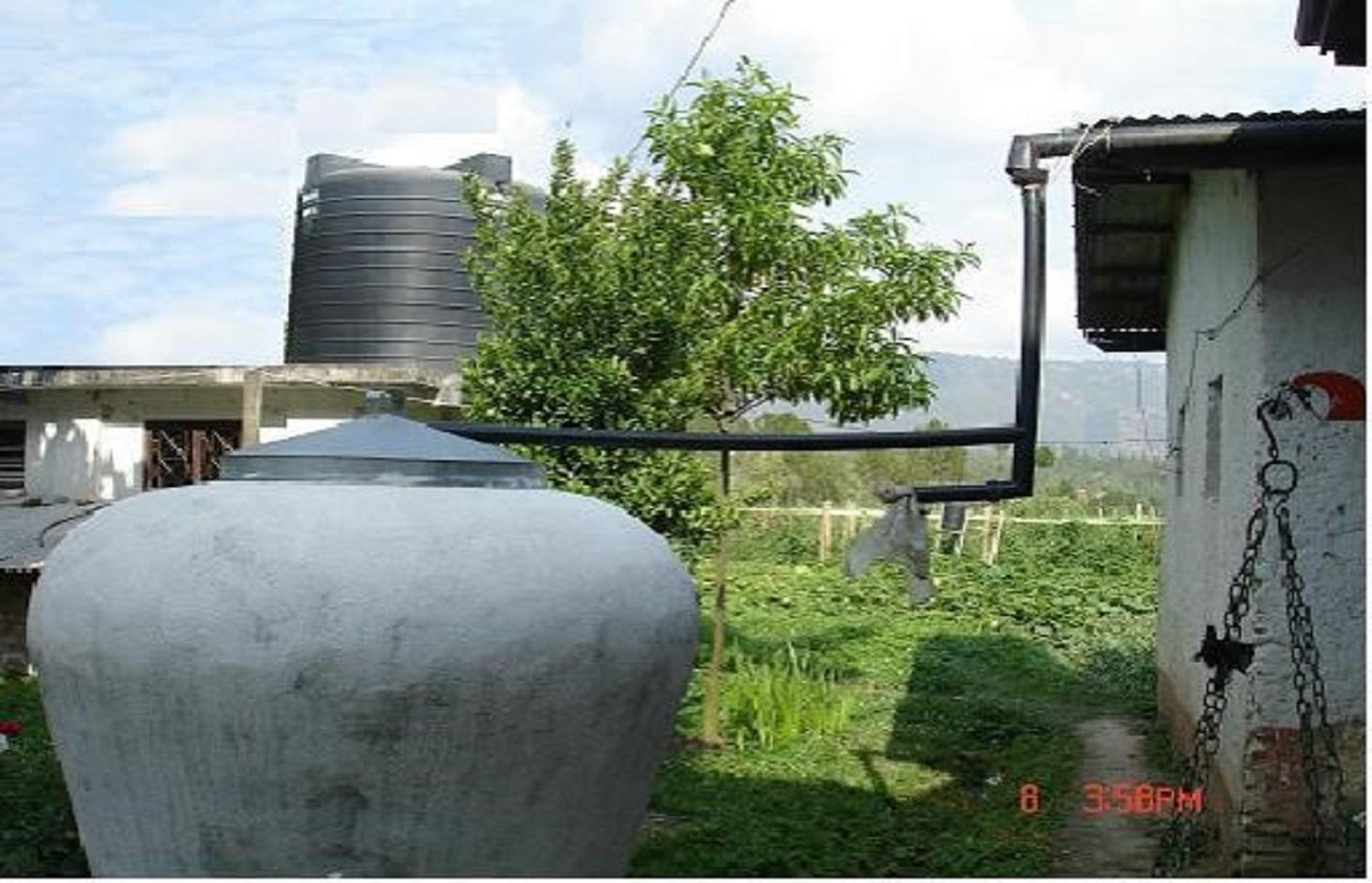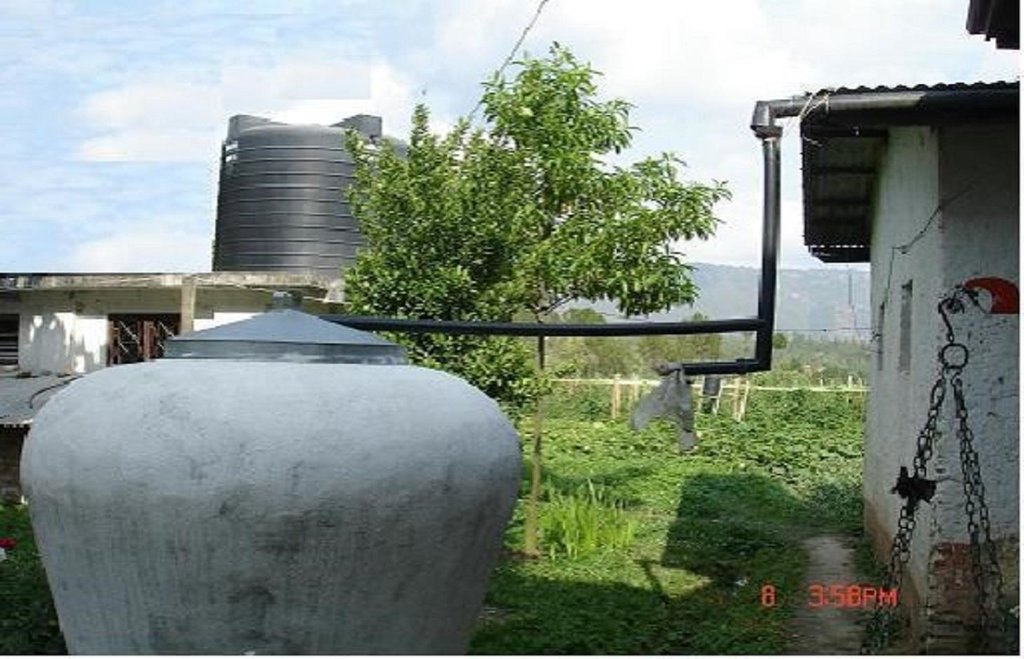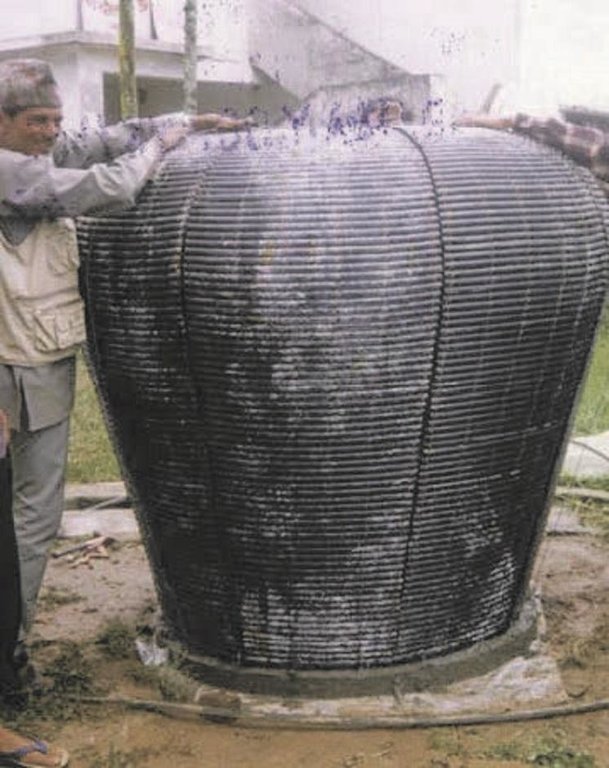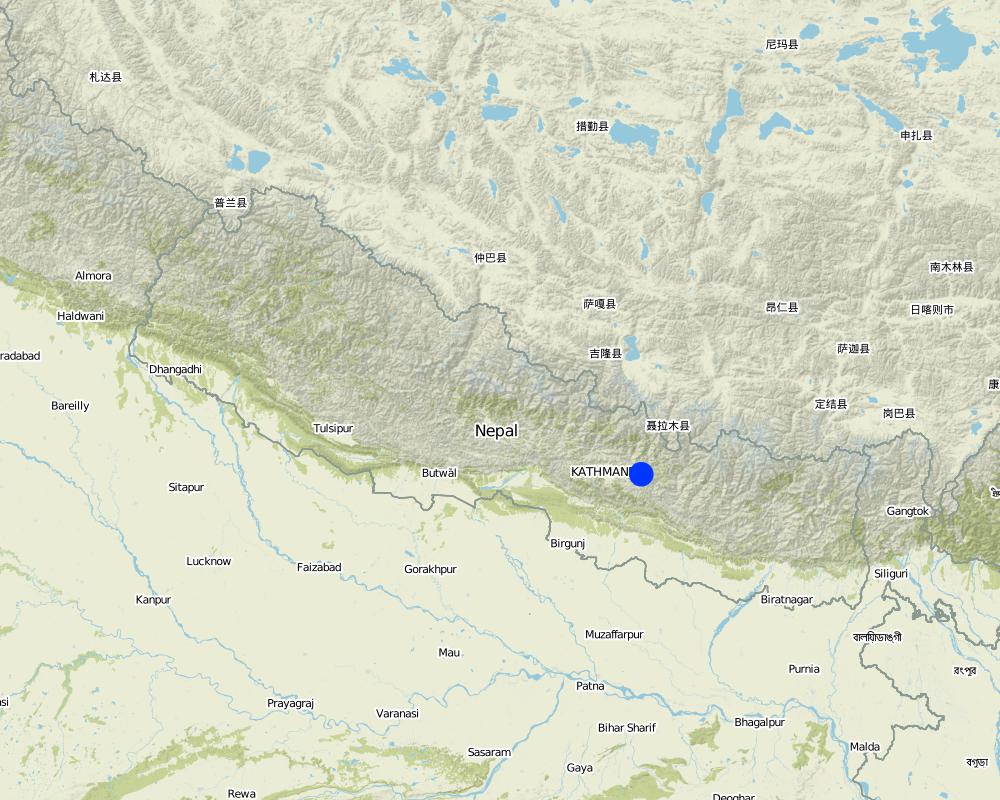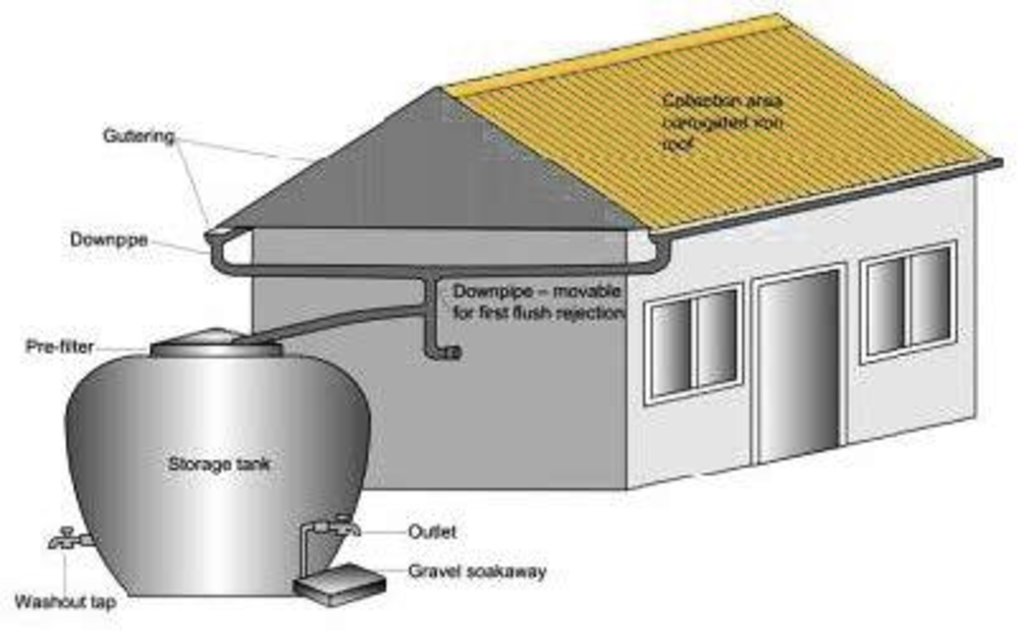Rooftop rainwater harvesting system [Nepal]
- Creación:
- Actualización:
- Compilador: Madhav Dhakal
- Editor: –
- Revisores: David Streiff, Deborah Niggli, Alexandra Gavilano
Akase paani sankalan pranali - Nepali
technologies_1497 - Nepal
Visualizar secciones
Expandir todo Colapsar todos1. Información general
1.2 Detalles de contacto de las personas de referencia e instituciones involucradas en la evaluación y la documentación de la Tecnología
Especialista MST:
Especialista MST:
Nombre del proyecto que financió la documentación/ evaluación de la Tecnología (si fuera relevante)
Book project: Water Harvesting – Guidelines to Good Practice (Water Harvesting)Nombre de la(s) institución(es) que facilitaron la documentación/ evaluación de la Tecnología (si fuera relevante)
ICIMOD International Centre for Integrated Mountain Development (ICIMOD) - Nepal1.3 Condiciones referidas al uso de datos documentados mediante WOCAT
El compilador y la/s persona(s) de referencia claves aceptan las condiciones acerca del uso de los datos documentados mediante WOCAT:
Sí
2. Descripción de la Tecnología MST
2.1 Breve descripción de la Tecnología
Definición de la Tecnología:
A water harvesting system in which rain falling on a roof is led through connecting pipes into a ferro-cement water collecting jar.
2.2 Descripción detallada de la Tecnología
Descripción:
Many households in Nepal’s midhills suffer from water shortages during the pronounced dry season. The technology described here - harvesting roofwater during times of heavy rainfall for later use - is a promising way of improving people’s access to water for household use, especially for households with no or only limited access to spring or stream water. The technology has yet to be extensively adopted in Nepal’s midhills.
Purpose of the Technology: The technology was introduced in the Jhikhu Khola watershed to demonstrate an alternative source of water for domestic use (mainly drinking water). This technology is appropriate for scattered rural households in mountaineous areas. The harvesting system consists of a catchment roof, conveyance pipes, and a storage jar. The pipes include a gutter system made from longitudinally split polythene pipe which has a flushing system that allows the system to be periodically flushed clean.
The collected water enters a 500 or 2000 litre capacity ferro-cement jar made using a mould (see photo). A preconstructed mould made from iron rods and polythene pipes is installed on a concrete base plate. Metal wires are extended from the base plate over the main mould to the top. Chicken mesh is then wrapped over the mould and tied securely with thin wire. A cement coating is applied over the metal structure. The jar is finished with three coatings of cement and the opening is covered with a fine nylon mesh to filter out undesired coarse matter. A tin lid is placed over the top.
Establishment / maintenance activities and inputs: A tap is fixed about 20 cm above the ground. This height allows for water to be collected in the typical 15 litre local water vessels (gagri) and avoids collection of too much water in bigger vessels as well as minimising the dead storage of water (Nakarmi et al. 2003). Trained masons can easily install the entire system. Provided all the materials and the mould are available, the entire system can be put together in about a week. The main maintenance task is to keep the roof clean, especially after long dry periods. This is done using the gutter pipe flushing system in which the first dirty water from the roof is diverted away from the jar.
2.3 Fotografías de la Tecnología
2.5 País/ región/ lugares donde la Tecnología fue aplicada y que se hallan comprendidos por esta evaluación
País:
Nepal
Región/ Estado/ Provincia:
Kharelthok, Sathighar, Panchkhal, Hokse and Patalekhet VDCs of the Jhikhu Khola watershed
Especifique más el lugar :
Kavrepalanchowk district
Especifique la difusión de la Tecnología:
- aplicada en puntos específicos/ concentrada en un área pequeña
Comentarios:
Roof rainwater harvesting jars were demonstrated mostly in the villages located at the watershed divides, hilltops, and elevated terraces where communities face chronic water shortage particularly during the dry period.
Map
×2.6 Fecha de la implementación
Si no se conoce el año preciso, indique la fecha aproximada:
- hace menos de 10 años (recientemente)
2.7 Introducción de la Tecnología
Especifique cómo se introdujo la Tecnología:
- mediante proyectos/ intervenciones externas
Comentarios (tipo de proyecto, etc.):
Water harvesting is an ancient practice, the system used in the Jhikhu Khola watershed came from Thailand, so the technology is often called 'Thai jar". In Nepal, the Rural Water Supply and Sanitation Support Programme (RWSSSP), which is jointly funded by the Government of Finland and His Majesties Government of Nepal, introduced it in the water deficit districts of western Nepal (Arghakhanchi, Gulmi, Kapilvastu, Nawalparasi, Palpa, Parbat, and Rupandehi).
3. Clasificación de la Tecnología MST
3.1 Propósito(s) principal(es) de la Tecnología MST
- Access to water
3.2 Tipo(s) actuales de uso de la tierra donde se aplica la Tecnología

asentamientos, infraestructura
- Asentamientos, edificios
Comentarios:
courtyard
Comentarios:
Major land use problems (compiler’s opinion): Inadequate water supply during the late winter and pre-monsoon months and sediment contamination during the wet season. The discharge from traditional water sources like dug-out ponds, springs, seepage ‘holes’, shallow wells and streamlets becomes limited soon after the end of the monsoon.
Major land use problems (land users’ perception): Many settlements are located on ridge tops and most water sources are located below making it difficult to provide water to households through networks of pipes. Women and girls often face hardship in carrying the water uphill, especially during the monsoon when trails are slippery.
Constraints of settlement / urban
Number of growing seasons per year: 3
Longest growing period in days: 150; Longest growing period from month to month: Jun - Oct; Second longest growing period in days: 120; Second longest growing period from month to month: Nov - Feb
3.5 Grupo MST al que pertenece la Tecnología
- cosecha de agua
3.6 Medidas MST que componen la Tecnología

medidas estructurales
- S5: Diques, hondonadas, estanques
3.7 Principales tipos de degradación del suelo encarados con la Tecnología

deterioro físico del suelo
- Pw: encharcamiento
Comentarios:
Main causes of degradation: change of seasonal rainfall
3.8 Prevención, reducción o restauración de la degradación del suelo
Especifique la meta de la Tecnología con relación a la degradación de la tierra:
- reducir la degradación del suelo
4. Especificaciones técnicas, actividades de implementación, insumos y costos
4.1 Dibujo técnico de la Tecnología
Especificaciones técnicas (relacionadas al dibujo técnico):
A water harvesting system with roof catchment, connecting pipes and storage tank.
Technical knowledge required for field staff / advisors: high
Technical knowledge required for land users: high
Main technical functions: water harvesting / increase water supply
Structural measure: Dam/ pan/ pond
Material: Concrete
Structural measure: Jar
Structural measure: Gutter
Structural measure: pipes
Construction material (other): Cement
Autor:
A.K. Thaku
4.2 Información general sobre el cálculo de insumos y costos
Especifique cómo se calcularon los costos e insumos:
- por unidad de Tecnología
Especifique unidad:
Rooftop rainwater harvesting system
Especifique la moneda usada para calcular costos:
- USD
Indique el costo promedio del salario de trabajo contratado por día:
2.10
4.3 Actividades de establecimiento
| Actividad | Momento (estación) | |
|---|---|---|
| 1. | Construct the concrete base plate with the help of base moluld | 1st day of a week |
| 2. | Curing work | 2nd to 7th days of a week |
| 3. | Final checking and metal cap putting over the top of the jar | 7th day of a week |
| 4. | First coat of cement | 2nd day of a week |
| 5. | Gutter and pipe fitting; including flush pipe | 4th day of a week |
| 6. | Inner coat of cement | 6th day of a week |
| 7. | Main mould installation with the help of metal wires, wrapping of chicken mesh | 2nd day of a week |
| 8. | Removal of mould | 6th day of a week |
| 9. | Second coat of cement | 3rd day of a week |
4.4 Costos e insumos necesarios para el establecimiento
| Especifique insumo | Unidad | Cantidad | Costos por unidad | Costos totales por insumo | % de los costos cubiertos por los usuarios de las tierras | |
|---|---|---|---|---|---|---|
| Mano de obra | Construction of rooftop rainwater harvesting system | Persons/unit | 19,5 | 2,1 | 40,95 | 25,0 |
| Material de construcción | Cement | unit | 1,0 | 23,6 | 23,6 | |
| Material de construcción | Sand and aggregate | unit | 1,0 | 1,4 | 1,4 | 100,0 |
| Material de construcción | Chicken wire mesh | unit | 1,0 | 20,9 | 20,9 | |
| Material de construcción | Metal jar cover | unit | 1,0 | 5,5 | 5,5 | |
| Material de construcción | Plastic sheet/mosquito screen | unit | 1,0 | 1,5 | 1,5 | |
| Material de construcción | Polyethylene, pipes, reducer | unit | 1,0 | 23,7 | 23,7 | |
| Material de construcción | Nail, clamps, pipe elbow etc. | unit | 1,0 | 3,6 | 3,6 | |
| Material de construcción | Brass tap. socket, seal tap | unit | 1,0 | 3,5 | 3,5 | |
| Otros | Paint | unit | 1,0 | 2,1 | 2,1 | |
| Costos totales para establecer la Tecnología | 126,75 | |||||
| Costos totales para establecer la Tecnología en USD | 126,75 | |||||
Comentarios:
Duration of establishment phase: 0.25 month(s)
Materials: cement (kg) 23.6 materials sand,aggregate (m3) 1.4 100 materials chicken wire mesh (m) 17.5 materials Iron wire (kg) 3.3 materials metal jar cover (no) 5.5 materials mosquito screen (m) 0.5 materials plastic sheet (m) 1 materials binding wire (kg) 0.1 materials snowcem paint (kg) 1.4 materials enamail paint (litre) 0.7 materials 90 mm HDP pipe (m) 10.3 materials 63 mm HDP pipe (m) 6.2 materials 40 mm HDP pipe (m) 6.8 materials reducer (no) 0.4 materials plain and roofing nails (kg) 0.2 materials metal clamp (no) 1.4 materials elbow, tee,end cap (no) 2.1 materials brass tap with latches (no) 2.1 materials 0 .5*10 inch GI nipple(no) 0.2 materials 1*10 inch GI nipple(no) 0.2 materials 1inch end cap (no) 0.7 materials GI socket (no) 0.2 materials thread seal tap (no) 0.1 Additional info Q 3.1.1.4: - less chance of disputes over turns to fetch water - medium General comments: Water harvesting is an ancient practice. The system used in the Jhikhu Khola watershed comes from Thailand, so the technology is often called ‘Thai jar’. In Nepal, the Rural Water Supply and Sanitation Support Programme (RWSSSP) introduced it in the water deficit districts of western Nepal.
4.5 Actividades de establecimiento/ recurrentes
| Actividad | Momento/ frequencia | |
|---|---|---|
| 1. | Cleaning the jar | dry months/one or twice in a year |
| 2. | Flushing contaminated water | After a long dry spell/whenever required |
4.6 Costos e insumos necesarios para actividades de mantenimiento/ recurrentes (por año)
| Especifique insumo | Unidad | Cantidad | Costos por unidad | Costos totales por insumo | % de los costos cubiertos por los usuarios de las tierras | |
|---|---|---|---|---|---|---|
| Mano de obra | Cleaning the system | Persons/unit | 7,0 | 2,1 | 14,7 | 100,0 |
| Indique los costos totales para mantenecer la Tecnología | 14,7 | |||||
| Costos totales para mantener la Tecnología en USD | 14,7 | |||||
Comentarios:
Machinery/ tools: hacksaw, steel scissors, hammer, pliers, wrench, trowel, steel pan bucket, and jug
Per unit cost of structure. The above mentioned cost is for unit water harvesting system. It can not be converted into hectare basis. It was estimated in 2006.
4.7 Factores más determinantes que afectan los costos:
Describa los factores más determinantes que afectan los costos:
The mould and tools were provided by the project and can be used to install many water harvesting systems. Therefore, the cost of tools are not included here. Material costs fluctuate from time to time. The transport costs will vary according to the remoteness of the site. During 1999/2000, the cost of a system varied from US$80 to US$120, of which land users contributed about US$40 by providing the unskilled labour and locally available materials like sand and fine aggregates (calculated at an exchange rate of US$1 = NRs 73).
5. Entorno natural y humano
5.1 Clima
Lluvia anual
- < 250 mm
- 251-500 mm
- 501-750 mm
- 751-1,000 mm
- 1,001-1,500 mm
- 1,501-2,000 mm
- 2,001-3,000 mm
- 3,001-4,000 mm
- > 4,000 mm
Zona agroclimática
- húmeda
Thermal climate class: subtropics
5.2 Topografía
Pendientes en promedio:
- plana (0-2 %)
- ligera (3-5%)
- moderada (6-10%)
- ondulada (11-15%)
- accidentada (16-30%)
- empinada (31-60%)
- muy empinada (>60%)
Formaciones telúricas:
- meseta/ planicies
- cordilleras
- laderas montañosas
- laderas de cerro
- pies de monte
- fondo del valle
Zona altitudinal:
- 0-100 m s.n.m.
- 101-500 m s.n.m.
- 501-1,000 m s.n.m
- 1,001-1,500 m s.n.m
- 1,501-2,000 m s.n.m
- 2,001-2,500 m s.n.m
- 2,501-3,000 m s.n.m
- 3,001-4,000 m s.n.m
- > 4,000 m s.n.m
Comentarios y especificaciones adicionales sobre topografía :
Landforms: Also valley floors
5.4 Disponibilidad y calidad de agua
Calidad de agua (sin tratar):
agua potable de mala calidad (requiere tratamiento)
Comentarios y especificaciones adicionales sobre calidad y cantidad de agua:
Water quality (untreated): More in rainy season (June- September), less in April/May
5.6 Las características de los usuarios de la tierra que aplican la Tecnología
Ingresos no agrarios:
- 10-50% de todo el ingreso
Nivel relativo de riqueza:
- pobre
Individuos o grupos:
- individual/ doméstico
Género:
- mujeres
- hombres
Indique otras características relevantes de los usuarios de las tierras:
Land users applying the Technology are mainly common / average land users
Population density: 200-500 persons/km2
Annual population growth: 2% - 3%
15% of the land users are rich and own 35% of the land.
35% of the land users are average wealthy and own 40% of the land.
50% of the land users are poor and own 25% of the land (as ranked by the land users).
Off-farm income specification: In most farm households off-farm income plays at least a minor and increasingly a major role. Occasional opportunities for off-farm income present themselves in the form of daily
5.7 Área promedio de la tierra usada por usuarios de tierra que aplican la Tecnología
- < 0.5 ha
- 0.5-1 ha
- 1-2 ha
- 2-5 ha
- 5-15 ha
- 15-50 ha
- 50-100 ha
- 100-500 ha
- 500-1,000 ha
- 1,000-10,000 ha
- > 10,000 ha
¿Esto se considera de pequeña, mediana o gran escala (refiriéndose al contexto local)?
- escala mediana
5.8 Tenencia de tierra, uso de tierra y derechos de uso de agua
Tenencia de tierra:
- individual, con título
Derechos de uso de tierra:
- individual
Derechos de uso de agua:
- comunitarios (organizado)
6. Impactos y comentarios para concluir
6.1 Impactos in situ demostrados por la Tecnología
Impactos socioeconómicos
Producción
área de producción
Comentarios/ especifique:
by the house to accommodate the water jar
Disponibilidad y calidad de agua
disponibilidad de agua potable
Comentarios/ especifique:
in dry seasons
harvested water can be used during busy periods ( field preparation, vegetable planting, rice harvesting, and festivals).
Ingreso y costos
carga de trabajo
Cantidad antes de MST:
1 hour
Cantidad luego de MST:
5 minutes
Comentarios/ especifique:
greatly reduced time needed to fetch water
reduced women's workload i.e. per day water fetching time reduced from about 12 hours to about 1 hour ( for the households having ~10 family members).
Otros impactos socioeconómicos
Water is available near the house
Comentarios/ especifique:
A house hold having 10 family member require about 12 gagree ( 1 gagree is equivalent to15 litre)
Impactos socioculturales
instituciones comunitarias
Comentarios/ especifique:
together with adopters, other potential local adopters have started discussing options
MST/ conocimiento de la degradación del suelo
Comentarios/ especifique:
through training, demonstration, and knowledge sharing
livelihood and human well-being
Comentarios/ especifique:
Improved heath condition due to clean water availability
Sanitation
Comentarios/ especifique:
more water avilable forwashing leading to improved health
Risk of injury from carrying water along slippery and steep tracks
6.2 Impactos fuera del sitio demostrados por la Tecnología
inundaciones río abajo
Comentarios/ especifique:
a little portion of rainfall traped directly from the roof and collected at the courtyard
colmatación río abajo
Comentarios/ especifique:
reduced eroded materials from the courtyard.
availability of water for neighbours during scarce period
6.3 Exposición y sensibilidad de la Tecnología al cambio climático gradual y a extremos relacionados al clima/ desastres (desde la percepción de los usuarios de tierras)
Cambio climático gradual
Cambio climático gradual
| Estación | Incremento o reducción | ¿Cómo es que la tecnología soporta esto? | |
|---|---|---|---|
| temperatura anual | incrementó | bien |
Extremos (desastres) relacionados al clima
Desastres climatológicos:
| ¿Cómo es que la tecnología soporta esto? | |
|---|---|
| tormenta de lluvia local | bien |
| tormenta de viento | bien |
Desastres climatológicos
| ¿Cómo es que la tecnología soporta esto? | |
|---|---|
| sequía | no muy bien |
Desastres hidrológicos
| ¿Cómo es que la tecnología soporta esto? | |
|---|---|
| inundación general (río) | bien |
Otras consecuencias relacionadas al clima
Otras consecuencias relacionadas al clima
| ¿Cómo es que la tecnología soporta esto? | |
|---|---|
| periodo reducido de crecimiento | bien |
6.4 Análisis costo-beneficio
¿Cómo se comparan los beneficios con los costos de establecimiento (desde la perspectiva de los usuarios de tierra)?
Ingresos a corto plazo:
ligeramente negativo
Ingresos a largo plazo:
muy positivo
¿Cómo se comparan los beneficios con los costos de mantenimiento/ recurrentes (desde la perspectiva de los usuarios de tierra)?
Ingresos a corto plazo:
muy positivo
Ingresos a largo plazo:
muy positivo
Comentarios:
Although the initial investment is high, the users immediately get more water. The high cost of installing the system means that the short term benefits are slightly negative.
6.5 Adopción de la Tecnología
- casos individuales / experimentales
Si tiene la información disponible, cuantifique (número de hogares y/o área cubierta):
46 households in an area of 1 - 10 sq km (200 - 500 persons/sq km)
De todos quienes adoptaron la Tecnología, ¿cuántos lo hicieron espontáneamente, por ej. sin recibir nada de incentivos/ materiales:
- 11-50%
Comentarios:
74% of land user families have adopted the Technology with external material support
34 land user families have adopted the Technology with external material support
Comments on acceptance with external material support: survey results
26% of land user families have adopted the Technology without any external material support
12 land user families have adopted the Technology without any external material support
Comments on spontaneous adoption: survey results
There is a little trend towards spontaneous adoption of the Technology
Comments on adoption trend: The number of households applying the technology is increasing without further incentives being provided.
6.7 Fuerzas/ ventajas/ oportunidades de la Tecnología
| Fuerzas/ ventajas/ oportunidades desde la perspectiva del usuario de la tierra |
|---|
|
The stored water can be kept for use in emergencies such as to prepare food for guests during busy times like rice planting and harvesting, and during festivals. How can they be sustained / enhanced? Share experiences to extend adoption of the technology |
|
Harvested water is tastier due to being cooler compared to the water collected in the polythene tank. How can they be sustained / enhanced? Laboratory analysis of the harvested rainwater in different time period, i.e. from 1st month of harvest to 12th month could help to know the quality status. |
| Fuerzas/ ventajas/ oportunidades desde la perspectiva del compilador o de otra persona de referencia clave |
|---|
|
Harvested rainwater has saved almost one workday per day per family due to reduced water fetching time in this case referring to the rainy season, however water will generally be used during the dry season. How can they be sustained / enhanced? Publicise the economic benefits of the technology through experience sharing programmes. |
|
Women are responsible for fetching water and so the technology reduces their workloads. How can they be sustained / enhanced? Implement a larger scale programme to promote the technology. |
|
The jars are more durable than plastic tanks. How can they be sustained / enhanced? Carry out regular maintenance to keep systems in good working order. |
6.8 Debilidades/ desventajas/ riesgos de la Tecnología y formas de sobreponerse a ellos
| Debilidades/ desventajas/ riesgos desde la perspectiva del usuario de la tierra | ¿Cómo sobreponerse a ellas? |
|---|---|
| The technology is expensive for poor households. | External support is needed for poor households to afford this system. |
| The height of the tap is very low which makes it inconvenient to collect water in the gagree. | It was designed to use collected water efficiently, the tap height can be raised, which means that the dead storage is increased, i.e. more water is unavailable for use. |
| There are chances of the jar’s base plate subsiding due to lack of compactness of foundation. | The area of base plate should be made more compact. |
| Debilidades/ desventajas/ riesgos desde la perspectiva del compilador o de otra persona de referencia clave | ¿Cómo sobreponerse a ellas? |
|---|---|
| 2,000 litre capacity jars barely meet the dry season needs of a household. | Larger sized jars or more than one jar need to be built to meet most household’s requirements. |
| Microbiological contamination (total and faecal coliform bacteria) and levels of phosphate above the EC maximum were found in a number of the jars caused by bird droppings and dust particles from the roof. | Regularly clean catchment roofs and treat water before drinking by boiling or chlorinating. Rainwater has a low mineral content which can be harmful for the human body, if taken in large quantities (due to reverse osmosis process). |
| This technology is not suitable for temple roofs because such roofs are usually home to large numbers of pigeons, and their excreta will contaminate rainwater that falls there. | Avoid badly contaminated catchments. |
7. Referencias y vínculos
7.1 Métodos/ fuentes de información
7.2 Vínculos a las publicaciones disponibles
Título, autor, año, ISBN:
Sharma, C. (2001) Socioeconomic IndicativeImpact Assessment and Benchmark Study on Rooftop Rainwater Harvesting, Kabhrepalanchok District, Nepal, a report submitted to ICIMOD, Kathmandu, Nepal
¿Dónde se halla disponible? ¿Costo?
ICIMOD
Título, autor, año, ISBN:
ICIMOD (2000) Water Harvesting Manual, unpublished manual prepared for PARDYP Project, ICIMOD
¿Dónde se halla disponible? ¿Costo?
ICIMOD
Título, autor, año, ISBN:
ICIMOD (2007) Good Practices in Watershed Management, Lessons Learned in the Mid Hills of Nepal. Kathmandu: ICIMOD
¿Dónde se halla disponible? ¿Costo?
ICIMOD
Título, autor, año, ISBN:
Lessons Learned from the People and Resource Dynamics Project , PARDYP/ICIMOD. 2006.
¿Dónde se halla disponible? ¿Costo?
ICIMOD
Título, autor, año, ISBN:
Nakarmi, G.; Merz, J.; Dhakal, M. (2003) ‘Harvesting Roof Water for Livelihood Improvement: A Case Studyof the Yarsha Khola Watershed, Eastern Nepal’. In News Bulletin of Nepal Geological Society, 20: 83-87
Título, autor, año, ISBN:
Nakarmi, G.; Merz, J. (2001) Harvesting Rain Water for Sustainable Water Supplies to Rural Households in the Yarsha Khola Watershed, a report submitted to Kirchgemeinde Zuoz, Switzerland and ICIMOD, Kathmandu, Nepal
¿Dónde se halla disponible? ¿Costo?
ICIMOD
Vínculos y módulos
Expandir todo Colapsar todosVínculos
No hay vínculos
Módulos
No se hallaron módulos


